GNED500 Social Analysis Report: Female Genital Mutilation, Fall 2016
VerifiedAdded on 2022/11/28
|9
|2266
|368
Report
AI Summary
This report provides a comprehensive social analysis of Female Genital Mutilation (FGM), examining its historical roots, types, and consequences. The report defines FGM, outlines its historical context, and details the different types, including clitoridectomy, excision, and infibulation. It delves into the social ideologies that perpetuate FGM, such as social pressure and traditional beliefs, and explores the short-term and long-term health and psychological consequences for affected individuals. The report also discusses the role of individuals in opposing FGM and offers recommendations for raising awareness and promoting change, emphasizing the importance of education and legal and social support. The analysis is framed within the context of a GNED500 assignment, adhering to the course's social analysis framework.
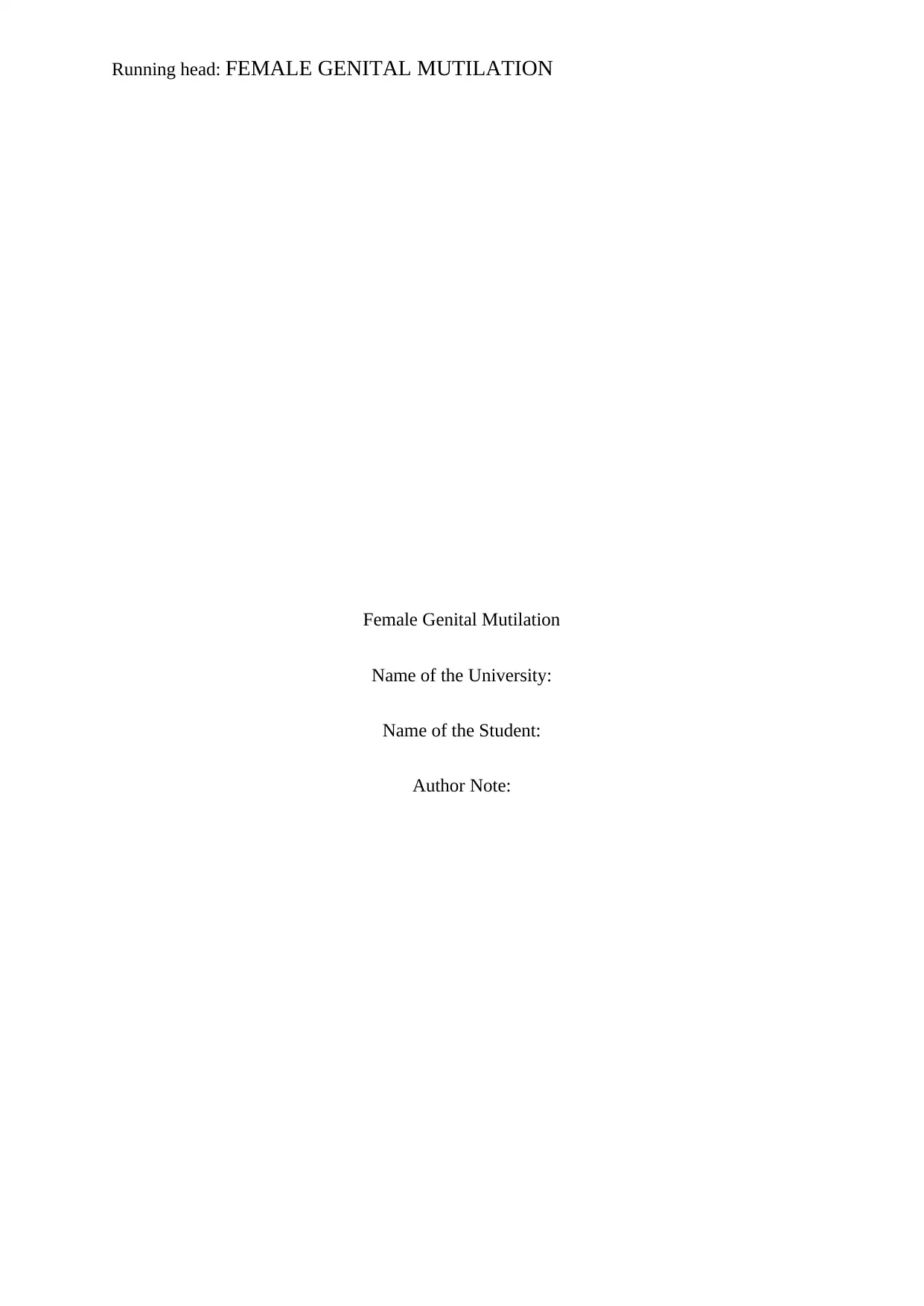
Running head: FEMALE GENITAL MUTILATION
Female Genital Mutilation
Name of the University:
Name of the Student:
Author Note:
Female Genital Mutilation
Name of the University:
Name of the Student:
Author Note:
Paraphrase This Document
Need a fresh take? Get an instant paraphrase of this document with our AI Paraphraser
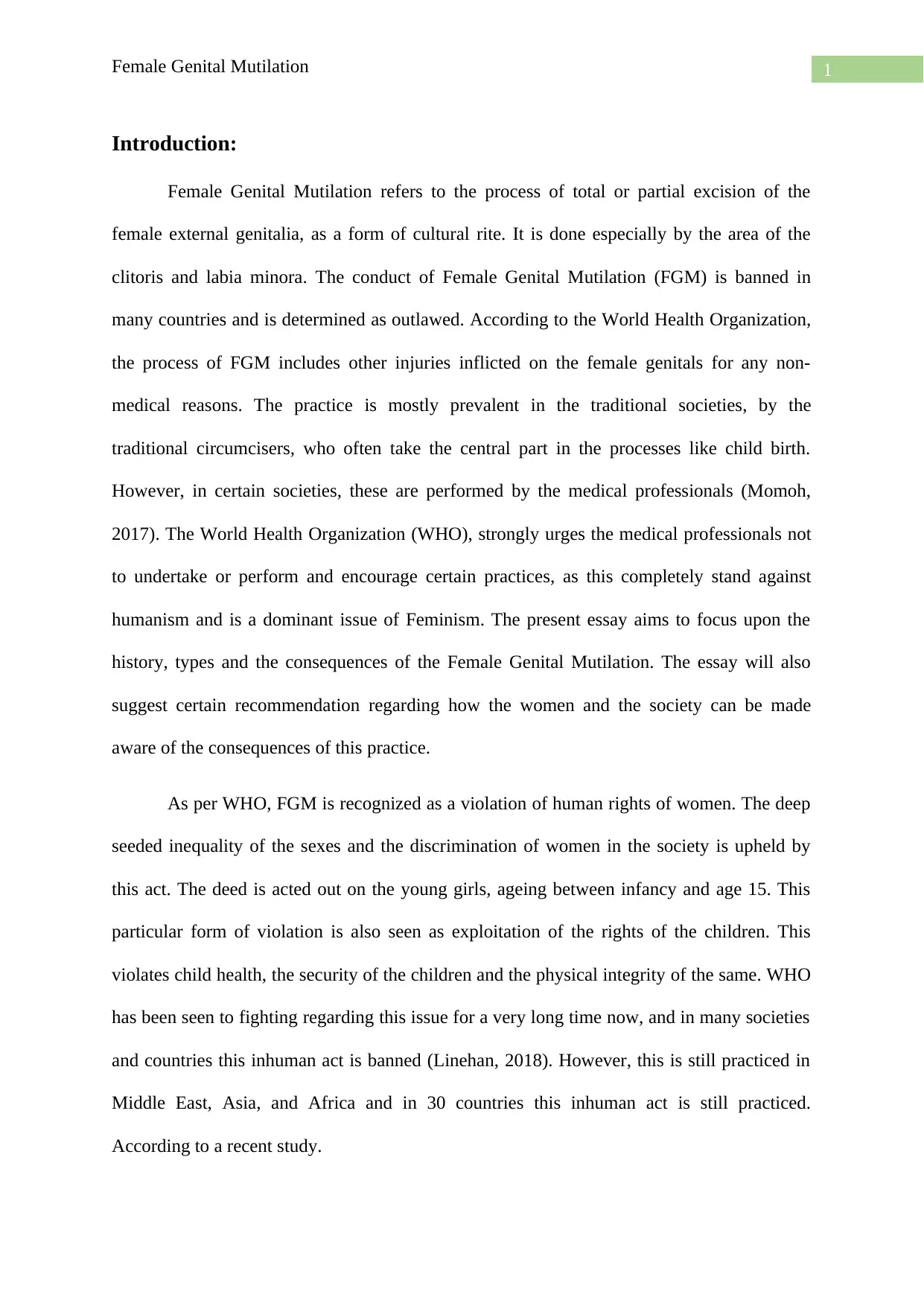
1Female Genital Mutilation
Introduction:
Female Genital Mutilation refers to the process of total or partial excision of the
female external genitalia, as a form of cultural rite. It is done especially by the area of the
clitoris and labia minora. The conduct of Female Genital Mutilation (FGM) is banned in
many countries and is determined as outlawed. According to the World Health Organization,
the process of FGM includes other injuries inflicted on the female genitals for any non-
medical reasons. The practice is mostly prevalent in the traditional societies, by the
traditional circumcisers, who often take the central part in the processes like child birth.
However, in certain societies, these are performed by the medical professionals (Momoh,
2017). The World Health Organization (WHO), strongly urges the medical professionals not
to undertake or perform and encourage certain practices, as this completely stand against
humanism and is a dominant issue of Feminism. The present essay aims to focus upon the
history, types and the consequences of the Female Genital Mutilation. The essay will also
suggest certain recommendation regarding how the women and the society can be made
aware of the consequences of this practice.
As per WHO, FGM is recognized as a violation of human rights of women. The deep
seeded inequality of the sexes and the discrimination of women in the society is upheld by
this act. The deed is acted out on the young girls, ageing between infancy and age 15. This
particular form of violation is also seen as exploitation of the rights of the children. This
violates child health, the security of the children and the physical integrity of the same. WHO
has been seen to fighting regarding this issue for a very long time now, and in many societies
and countries this inhuman act is banned (Linehan, 2018). However, this is still practiced in
Middle East, Asia, and Africa and in 30 countries this inhuman act is still practiced.
According to a recent study.
Introduction:
Female Genital Mutilation refers to the process of total or partial excision of the
female external genitalia, as a form of cultural rite. It is done especially by the area of the
clitoris and labia minora. The conduct of Female Genital Mutilation (FGM) is banned in
many countries and is determined as outlawed. According to the World Health Organization,
the process of FGM includes other injuries inflicted on the female genitals for any non-
medical reasons. The practice is mostly prevalent in the traditional societies, by the
traditional circumcisers, who often take the central part in the processes like child birth.
However, in certain societies, these are performed by the medical professionals (Momoh,
2017). The World Health Organization (WHO), strongly urges the medical professionals not
to undertake or perform and encourage certain practices, as this completely stand against
humanism and is a dominant issue of Feminism. The present essay aims to focus upon the
history, types and the consequences of the Female Genital Mutilation. The essay will also
suggest certain recommendation regarding how the women and the society can be made
aware of the consequences of this practice.
As per WHO, FGM is recognized as a violation of human rights of women. The deep
seeded inequality of the sexes and the discrimination of women in the society is upheld by
this act. The deed is acted out on the young girls, ageing between infancy and age 15. This
particular form of violation is also seen as exploitation of the rights of the children. This
violates child health, the security of the children and the physical integrity of the same. WHO
has been seen to fighting regarding this issue for a very long time now, and in many societies
and countries this inhuman act is banned (Linehan, 2018). However, this is still practiced in
Middle East, Asia, and Africa and in 30 countries this inhuman act is still practiced.
According to a recent study.
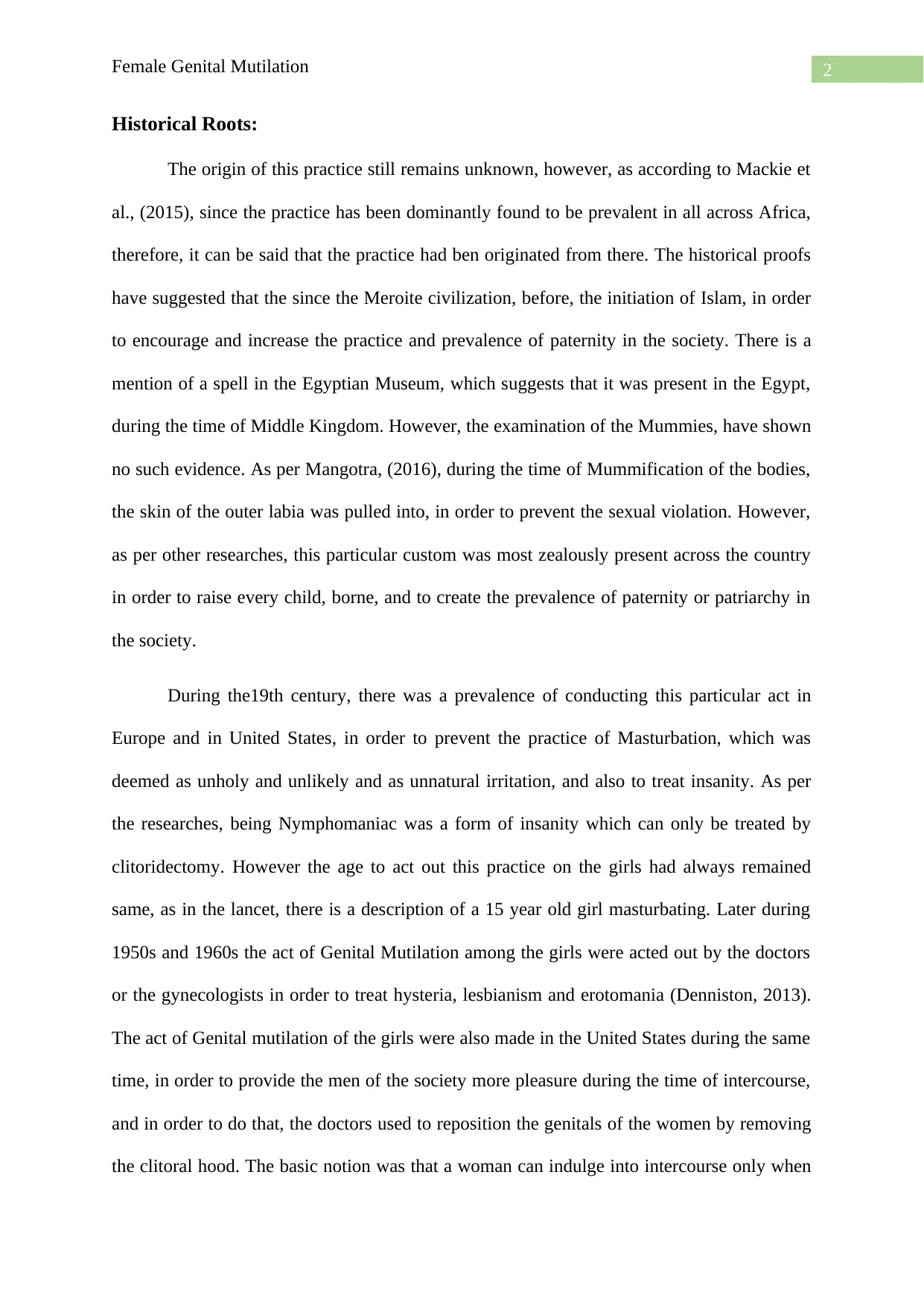
2Female Genital Mutilation
Historical Roots:
The origin of this practice still remains unknown, however, as according to Mackie et
al., (2015), since the practice has been dominantly found to be prevalent in all across Africa,
therefore, it can be said that the practice had ben originated from there. The historical proofs
have suggested that the since the Meroite civilization, before, the initiation of Islam, in order
to encourage and increase the practice and prevalence of paternity in the society. There is a
mention of a spell in the Egyptian Museum, which suggests that it was present in the Egypt,
during the time of Middle Kingdom. However, the examination of the Mummies, have shown
no such evidence. As per Mangotra, (2016), during the time of Mummification of the bodies,
the skin of the outer labia was pulled into, in order to prevent the sexual violation. However,
as per other researches, this particular custom was most zealously present across the country
in order to raise every child, borne, and to create the prevalence of paternity or patriarchy in
the society.
During the19th century, there was a prevalence of conducting this particular act in
Europe and in United States, in order to prevent the practice of Masturbation, which was
deemed as unholy and unlikely and as unnatural irritation, and also to treat insanity. As per
the researches, being Nymphomaniac was a form of insanity which can only be treated by
clitoridectomy. However the age to act out this practice on the girls had always remained
same, as in the lancet, there is a description of a 15 year old girl masturbating. Later during
1950s and 1960s the act of Genital Mutilation among the girls were acted out by the doctors
or the gynecologists in order to treat hysteria, lesbianism and erotomania (Denniston, 2013).
The act of Genital mutilation of the girls were also made in the United States during the same
time, in order to provide the men of the society more pleasure during the time of intercourse,
and in order to do that, the doctors used to reposition the genitals of the women by removing
the clitoral hood. The basic notion was that a woman can indulge into intercourse only when
Historical Roots:
The origin of this practice still remains unknown, however, as according to Mackie et
al., (2015), since the practice has been dominantly found to be prevalent in all across Africa,
therefore, it can be said that the practice had ben originated from there. The historical proofs
have suggested that the since the Meroite civilization, before, the initiation of Islam, in order
to encourage and increase the practice and prevalence of paternity in the society. There is a
mention of a spell in the Egyptian Museum, which suggests that it was present in the Egypt,
during the time of Middle Kingdom. However, the examination of the Mummies, have shown
no such evidence. As per Mangotra, (2016), during the time of Mummification of the bodies,
the skin of the outer labia was pulled into, in order to prevent the sexual violation. However,
as per other researches, this particular custom was most zealously present across the country
in order to raise every child, borne, and to create the prevalence of paternity or patriarchy in
the society.
During the19th century, there was a prevalence of conducting this particular act in
Europe and in United States, in order to prevent the practice of Masturbation, which was
deemed as unholy and unlikely and as unnatural irritation, and also to treat insanity. As per
the researches, being Nymphomaniac was a form of insanity which can only be treated by
clitoridectomy. However the age to act out this practice on the girls had always remained
same, as in the lancet, there is a description of a 15 year old girl masturbating. Later during
1950s and 1960s the act of Genital Mutilation among the girls were acted out by the doctors
or the gynecologists in order to treat hysteria, lesbianism and erotomania (Denniston, 2013).
The act of Genital mutilation of the girls were also made in the United States during the same
time, in order to provide the men of the society more pleasure during the time of intercourse,
and in order to do that, the doctors used to reposition the genitals of the women by removing
the clitoral hood. The basic notion was that a woman can indulge into intercourse only when
⊘ This is a preview!⊘
Do you want full access?
Subscribe today to unlock all pages.

Trusted by 1+ million students worldwide
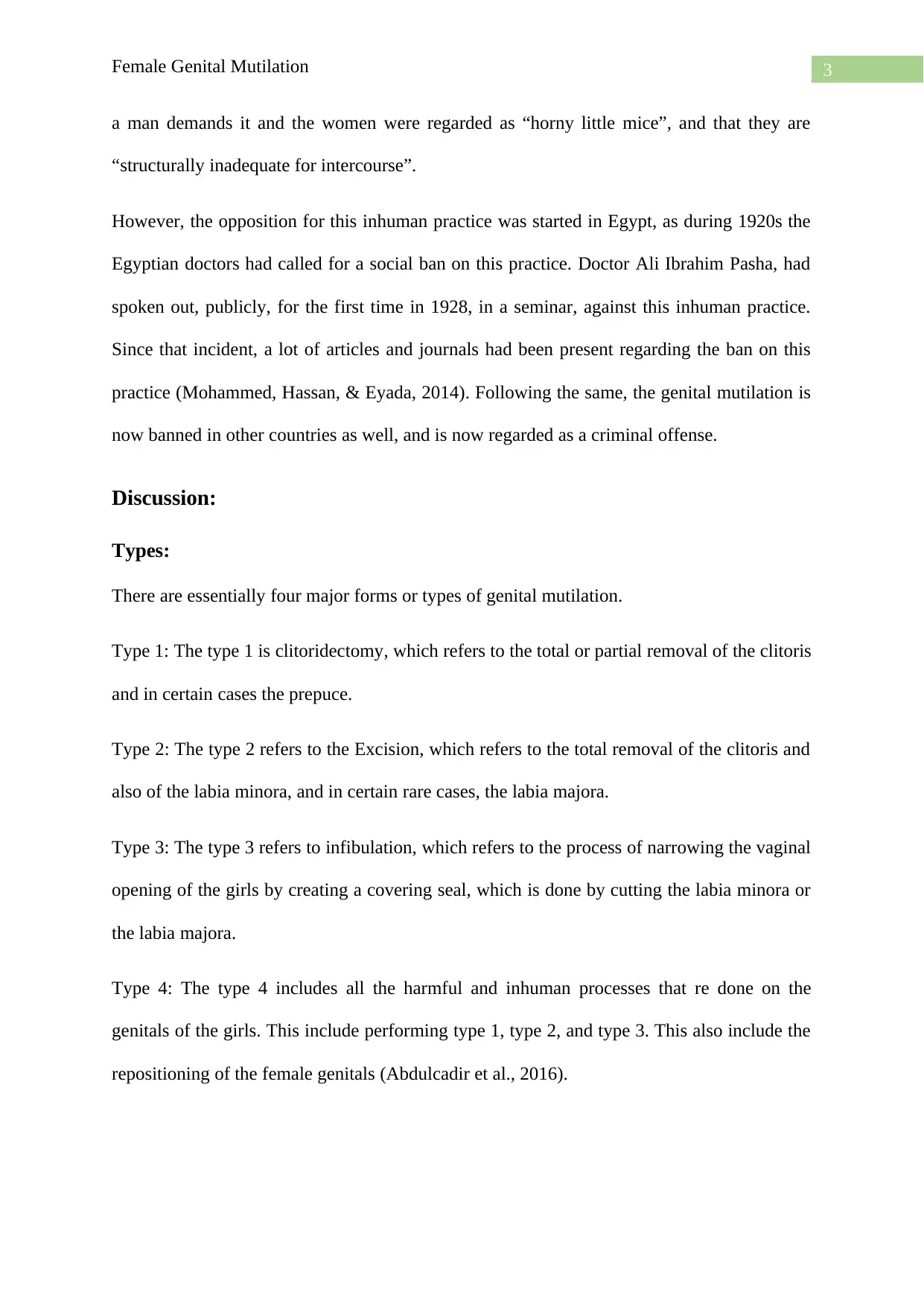
3Female Genital Mutilation
a man demands it and the women were regarded as “horny little mice”, and that they are
“structurally inadequate for intercourse”.
However, the opposition for this inhuman practice was started in Egypt, as during 1920s the
Egyptian doctors had called for a social ban on this practice. Doctor Ali Ibrahim Pasha, had
spoken out, publicly, for the first time in 1928, in a seminar, against this inhuman practice.
Since that incident, a lot of articles and journals had been present regarding the ban on this
practice (Mohammed, Hassan, & Eyada, 2014). Following the same, the genital mutilation is
now banned in other countries as well, and is now regarded as a criminal offense.
Discussion:
Types:
There are essentially four major forms or types of genital mutilation.
Type 1: The type 1 is clitoridectomy, which refers to the total or partial removal of the clitoris
and in certain cases the prepuce.
Type 2: The type 2 refers to the Excision, which refers to the total removal of the clitoris and
also of the labia minora, and in certain rare cases, the labia majora.
Type 3: The type 3 refers to infibulation, which refers to the process of narrowing the vaginal
opening of the girls by creating a covering seal, which is done by cutting the labia minora or
the labia majora.
Type 4: The type 4 includes all the harmful and inhuman processes that re done on the
genitals of the girls. This include performing type 1, type 2, and type 3. This also include the
repositioning of the female genitals (Abdulcadir et al., 2016).
a man demands it and the women were regarded as “horny little mice”, and that they are
“structurally inadequate for intercourse”.
However, the opposition for this inhuman practice was started in Egypt, as during 1920s the
Egyptian doctors had called for a social ban on this practice. Doctor Ali Ibrahim Pasha, had
spoken out, publicly, for the first time in 1928, in a seminar, against this inhuman practice.
Since that incident, a lot of articles and journals had been present regarding the ban on this
practice (Mohammed, Hassan, & Eyada, 2014). Following the same, the genital mutilation is
now banned in other countries as well, and is now regarded as a criminal offense.
Discussion:
Types:
There are essentially four major forms or types of genital mutilation.
Type 1: The type 1 is clitoridectomy, which refers to the total or partial removal of the clitoris
and in certain cases the prepuce.
Type 2: The type 2 refers to the Excision, which refers to the total removal of the clitoris and
also of the labia minora, and in certain rare cases, the labia majora.
Type 3: The type 3 refers to infibulation, which refers to the process of narrowing the vaginal
opening of the girls by creating a covering seal, which is done by cutting the labia minora or
the labia majora.
Type 4: The type 4 includes all the harmful and inhuman processes that re done on the
genitals of the girls. This include performing type 1, type 2, and type 3. This also include the
repositioning of the female genitals (Abdulcadir et al., 2016).
Paraphrase This Document
Need a fresh take? Get an instant paraphrase of this document with our AI Paraphraser
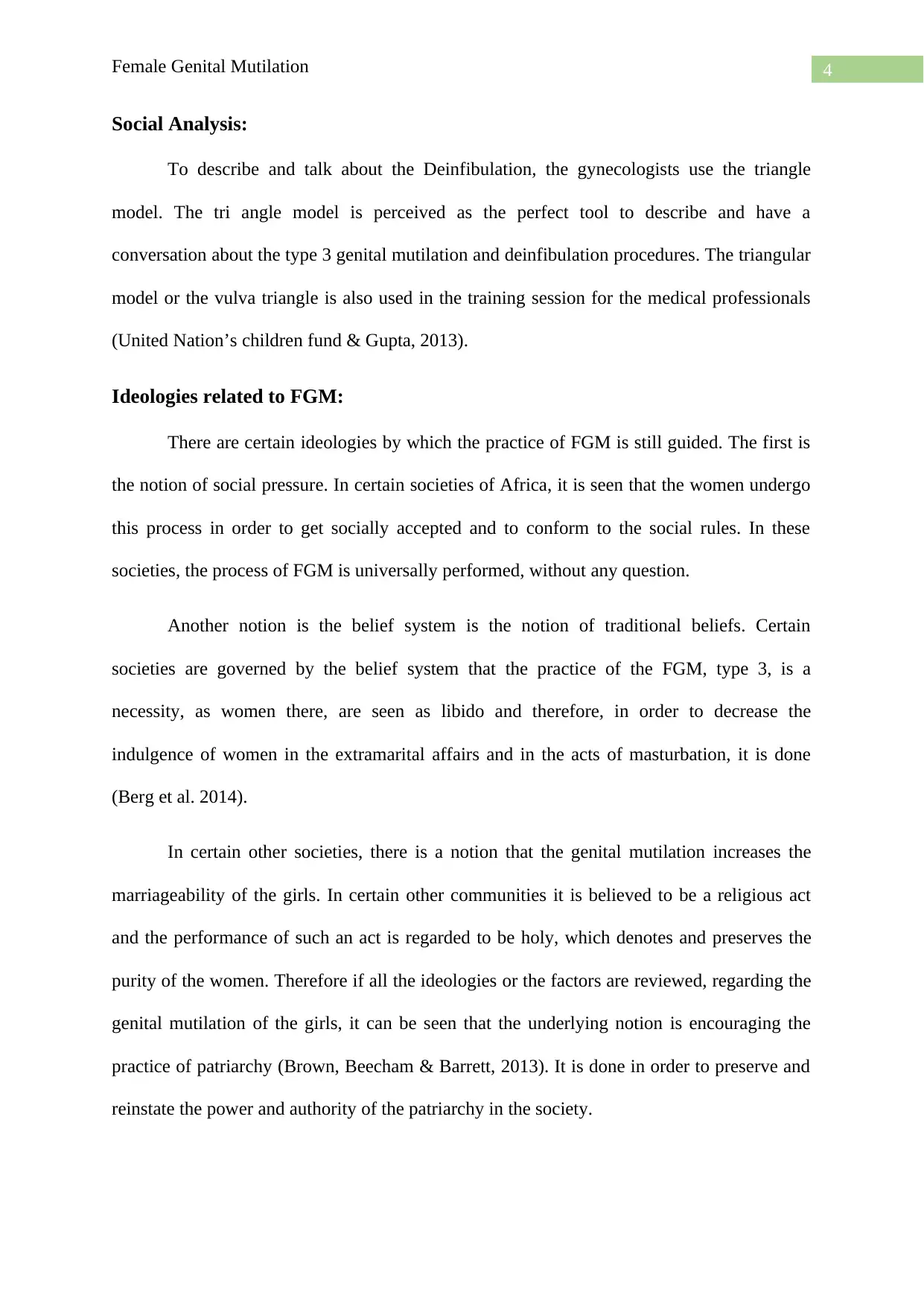
4Female Genital Mutilation
Social Analysis:
To describe and talk about the Deinfibulation, the gynecologists use the triangle
model. The tri angle model is perceived as the perfect tool to describe and have a
conversation about the type 3 genital mutilation and deinfibulation procedures. The triangular
model or the vulva triangle is also used in the training session for the medical professionals
(United Nation’s children fund & Gupta, 2013).
Ideologies related to FGM:
There are certain ideologies by which the practice of FGM is still guided. The first is
the notion of social pressure. In certain societies of Africa, it is seen that the women undergo
this process in order to get socially accepted and to conform to the social rules. In these
societies, the process of FGM is universally performed, without any question.
Another notion is the belief system is the notion of traditional beliefs. Certain
societies are governed by the belief system that the practice of the FGM, type 3, is a
necessity, as women there, are seen as libido and therefore, in order to decrease the
indulgence of women in the extramarital affairs and in the acts of masturbation, it is done
(Berg et al. 2014).
In certain other societies, there is a notion that the genital mutilation increases the
marriageability of the girls. In certain other communities it is believed to be a religious act
and the performance of such an act is regarded to be holy, which denotes and preserves the
purity of the women. Therefore if all the ideologies or the factors are reviewed, regarding the
genital mutilation of the girls, it can be seen that the underlying notion is encouraging the
practice of patriarchy (Brown, Beecham & Barrett, 2013). It is done in order to preserve and
reinstate the power and authority of the patriarchy in the society.
Social Analysis:
To describe and talk about the Deinfibulation, the gynecologists use the triangle
model. The tri angle model is perceived as the perfect tool to describe and have a
conversation about the type 3 genital mutilation and deinfibulation procedures. The triangular
model or the vulva triangle is also used in the training session for the medical professionals
(United Nation’s children fund & Gupta, 2013).
Ideologies related to FGM:
There are certain ideologies by which the practice of FGM is still guided. The first is
the notion of social pressure. In certain societies of Africa, it is seen that the women undergo
this process in order to get socially accepted and to conform to the social rules. In these
societies, the process of FGM is universally performed, without any question.
Another notion is the belief system is the notion of traditional beliefs. Certain
societies are governed by the belief system that the practice of the FGM, type 3, is a
necessity, as women there, are seen as libido and therefore, in order to decrease the
indulgence of women in the extramarital affairs and in the acts of masturbation, it is done
(Berg et al. 2014).
In certain other societies, there is a notion that the genital mutilation increases the
marriageability of the girls. In certain other communities it is believed to be a religious act
and the performance of such an act is regarded to be holy, which denotes and preserves the
purity of the women. Therefore if all the ideologies or the factors are reviewed, regarding the
genital mutilation of the girls, it can be seen that the underlying notion is encouraging the
practice of patriarchy (Brown, Beecham & Barrett, 2013). It is done in order to preserve and
reinstate the power and authority of the patriarchy in the society.
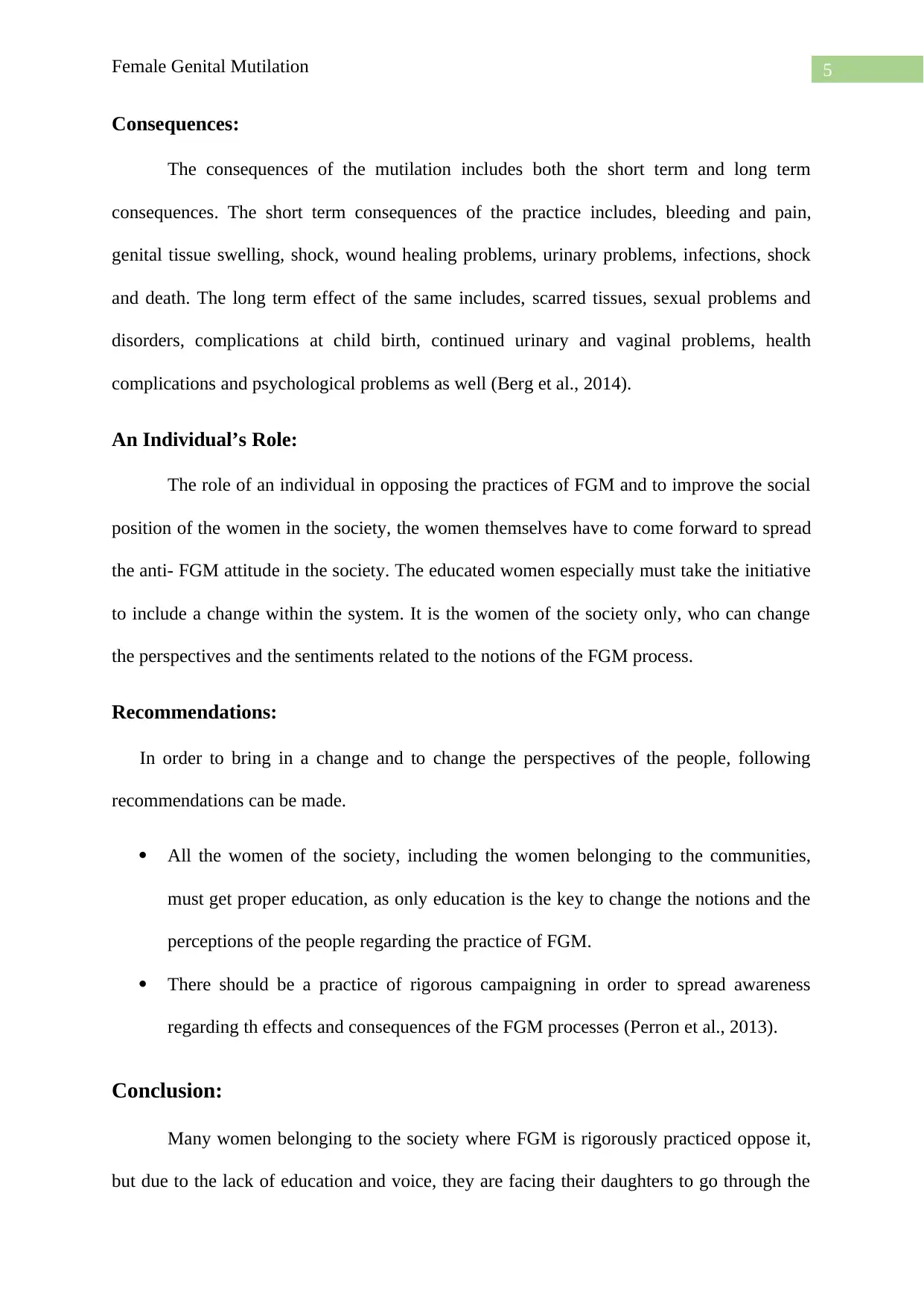
5Female Genital Mutilation
Consequences:
The consequences of the mutilation includes both the short term and long term
consequences. The short term consequences of the practice includes, bleeding and pain,
genital tissue swelling, shock, wound healing problems, urinary problems, infections, shock
and death. The long term effect of the same includes, scarred tissues, sexual problems and
disorders, complications at child birth, continued urinary and vaginal problems, health
complications and psychological problems as well (Berg et al., 2014).
An Individual’s Role:
The role of an individual in opposing the practices of FGM and to improve the social
position of the women in the society, the women themselves have to come forward to spread
the anti- FGM attitude in the society. The educated women especially must take the initiative
to include a change within the system. It is the women of the society only, who can change
the perspectives and the sentiments related to the notions of the FGM process.
Recommendations:
In order to bring in a change and to change the perspectives of the people, following
recommendations can be made.
All the women of the society, including the women belonging to the communities,
must get proper education, as only education is the key to change the notions and the
perceptions of the people regarding the practice of FGM.
There should be a practice of rigorous campaigning in order to spread awareness
regarding th effects and consequences of the FGM processes (Perron et al., 2013).
Conclusion:
Many women belonging to the society where FGM is rigorously practiced oppose it,
but due to the lack of education and voice, they are facing their daughters to go through the
Consequences:
The consequences of the mutilation includes both the short term and long term
consequences. The short term consequences of the practice includes, bleeding and pain,
genital tissue swelling, shock, wound healing problems, urinary problems, infections, shock
and death. The long term effect of the same includes, scarred tissues, sexual problems and
disorders, complications at child birth, continued urinary and vaginal problems, health
complications and psychological problems as well (Berg et al., 2014).
An Individual’s Role:
The role of an individual in opposing the practices of FGM and to improve the social
position of the women in the society, the women themselves have to come forward to spread
the anti- FGM attitude in the society. The educated women especially must take the initiative
to include a change within the system. It is the women of the society only, who can change
the perspectives and the sentiments related to the notions of the FGM process.
Recommendations:
In order to bring in a change and to change the perspectives of the people, following
recommendations can be made.
All the women of the society, including the women belonging to the communities,
must get proper education, as only education is the key to change the notions and the
perceptions of the people regarding the practice of FGM.
There should be a practice of rigorous campaigning in order to spread awareness
regarding th effects and consequences of the FGM processes (Perron et al., 2013).
Conclusion:
Many women belonging to the society where FGM is rigorously practiced oppose it,
but due to the lack of education and voice, they are facing their daughters to go through the
⊘ This is a preview!⊘
Do you want full access?
Subscribe today to unlock all pages.

Trusted by 1+ million students worldwide

6Female Genital Mutilation
same pain and they cannot do anything about it. Therefore, education and help, both legal and
social are much needed in these sectors.
same pain and they cannot do anything about it. Therefore, education and help, both legal and
social are much needed in these sectors.
Paraphrase This Document
Need a fresh take? Get an instant paraphrase of this document with our AI Paraphraser
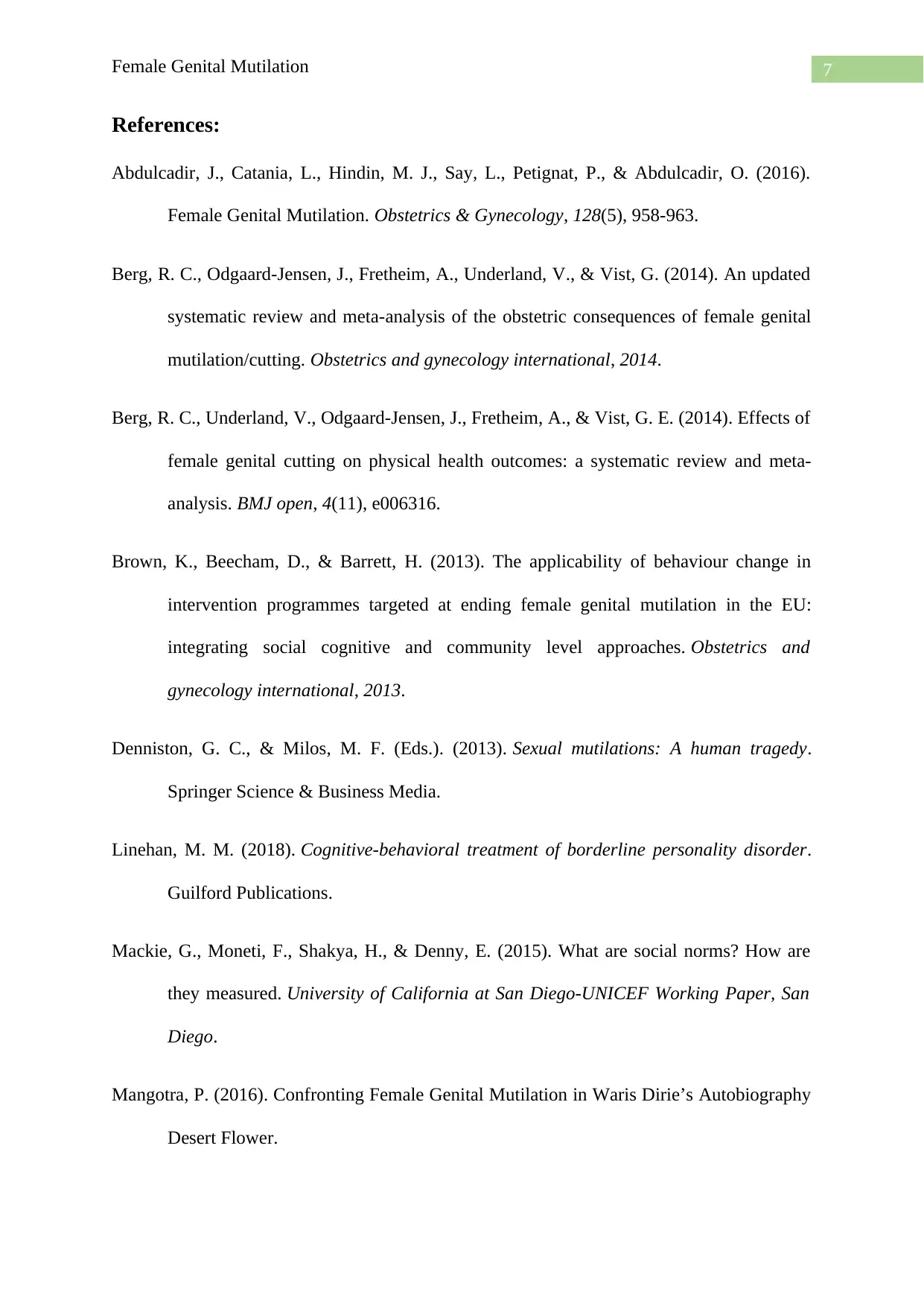
7Female Genital Mutilation
References:
Abdulcadir, J., Catania, L., Hindin, M. J., Say, L., Petignat, P., & Abdulcadir, O. (2016).
Female Genital Mutilation. Obstetrics & Gynecology, 128(5), 958-963.
Berg, R. C., Odgaard-Jensen, J., Fretheim, A., Underland, V., & Vist, G. (2014). An updated
systematic review and meta-analysis of the obstetric consequences of female genital
mutilation/cutting. Obstetrics and gynecology international, 2014.
Berg, R. C., Underland, V., Odgaard-Jensen, J., Fretheim, A., & Vist, G. E. (2014). Effects of
female genital cutting on physical health outcomes: a systematic review and meta-
analysis. BMJ open, 4(11), e006316.
Brown, K., Beecham, D., & Barrett, H. (2013). The applicability of behaviour change in
intervention programmes targeted at ending female genital mutilation in the EU:
integrating social cognitive and community level approaches. Obstetrics and
gynecology international, 2013.
Denniston, G. C., & Milos, M. F. (Eds.). (2013). Sexual mutilations: A human tragedy.
Springer Science & Business Media.
Linehan, M. M. (2018). Cognitive-behavioral treatment of borderline personality disorder.
Guilford Publications.
Mackie, G., Moneti, F., Shakya, H., & Denny, E. (2015). What are social norms? How are
they measured. University of California at San Diego-UNICEF Working Paper, San
Diego.
Mangotra, P. (2016). Confronting Female Genital Mutilation in Waris Dirie’s Autobiography
Desert Flower.
References:
Abdulcadir, J., Catania, L., Hindin, M. J., Say, L., Petignat, P., & Abdulcadir, O. (2016).
Female Genital Mutilation. Obstetrics & Gynecology, 128(5), 958-963.
Berg, R. C., Odgaard-Jensen, J., Fretheim, A., Underland, V., & Vist, G. (2014). An updated
systematic review and meta-analysis of the obstetric consequences of female genital
mutilation/cutting. Obstetrics and gynecology international, 2014.
Berg, R. C., Underland, V., Odgaard-Jensen, J., Fretheim, A., & Vist, G. E. (2014). Effects of
female genital cutting on physical health outcomes: a systematic review and meta-
analysis. BMJ open, 4(11), e006316.
Brown, K., Beecham, D., & Barrett, H. (2013). The applicability of behaviour change in
intervention programmes targeted at ending female genital mutilation in the EU:
integrating social cognitive and community level approaches. Obstetrics and
gynecology international, 2013.
Denniston, G. C., & Milos, M. F. (Eds.). (2013). Sexual mutilations: A human tragedy.
Springer Science & Business Media.
Linehan, M. M. (2018). Cognitive-behavioral treatment of borderline personality disorder.
Guilford Publications.
Mackie, G., Moneti, F., Shakya, H., & Denny, E. (2015). What are social norms? How are
they measured. University of California at San Diego-UNICEF Working Paper, San
Diego.
Mangotra, P. (2016). Confronting Female Genital Mutilation in Waris Dirie’s Autobiography
Desert Flower.
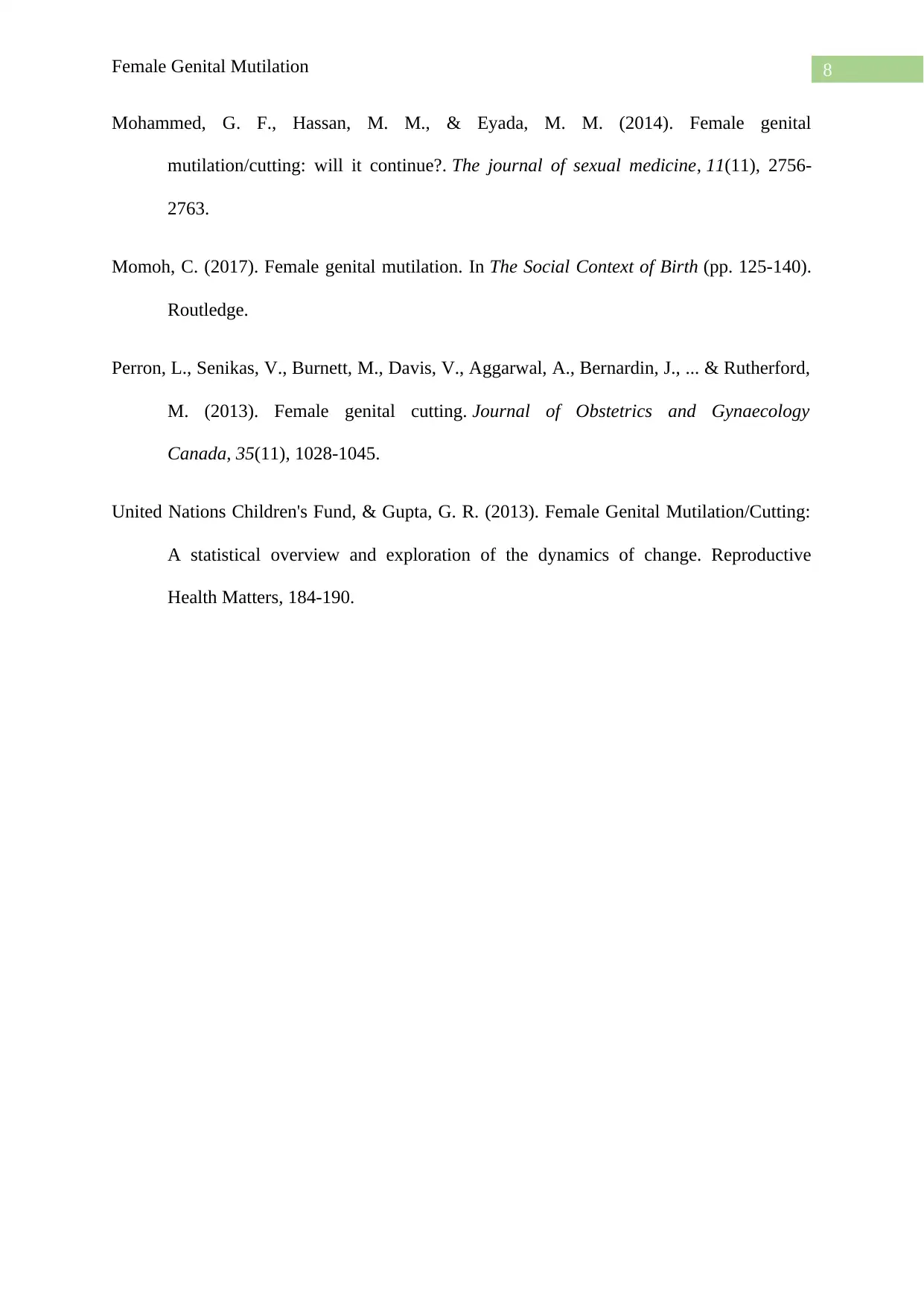
8Female Genital Mutilation
Mohammed, G. F., Hassan, M. M., & Eyada, M. M. (2014). Female genital
mutilation/cutting: will it continue?. The journal of sexual medicine, 11(11), 2756-
2763.
Momoh, C. (2017). Female genital mutilation. In The Social Context of Birth (pp. 125-140).
Routledge.
Perron, L., Senikas, V., Burnett, M., Davis, V., Aggarwal, A., Bernardin, J., ... & Rutherford,
M. (2013). Female genital cutting. Journal of Obstetrics and Gynaecology
Canada, 35(11), 1028-1045.
United Nations Children's Fund, & Gupta, G. R. (2013). Female Genital Mutilation/Cutting:
A statistical overview and exploration of the dynamics of change. Reproductive
Health Matters, 184-190.
Mohammed, G. F., Hassan, M. M., & Eyada, M. M. (2014). Female genital
mutilation/cutting: will it continue?. The journal of sexual medicine, 11(11), 2756-
2763.
Momoh, C. (2017). Female genital mutilation. In The Social Context of Birth (pp. 125-140).
Routledge.
Perron, L., Senikas, V., Burnett, M., Davis, V., Aggarwal, A., Bernardin, J., ... & Rutherford,
M. (2013). Female genital cutting. Journal of Obstetrics and Gynaecology
Canada, 35(11), 1028-1045.
United Nations Children's Fund, & Gupta, G. R. (2013). Female Genital Mutilation/Cutting:
A statistical overview and exploration of the dynamics of change. Reproductive
Health Matters, 184-190.
⊘ This is a preview!⊘
Do you want full access?
Subscribe today to unlock all pages.

Trusted by 1+ million students worldwide
1 out of 9
Related Documents
Your All-in-One AI-Powered Toolkit for Academic Success.
+13062052269
info@desklib.com
Available 24*7 on WhatsApp / Email
![[object Object]](/_next/static/media/star-bottom.7253800d.svg)
Unlock your academic potential
Copyright © 2020–2025 A2Z Services. All Rights Reserved. Developed and managed by ZUCOL.



